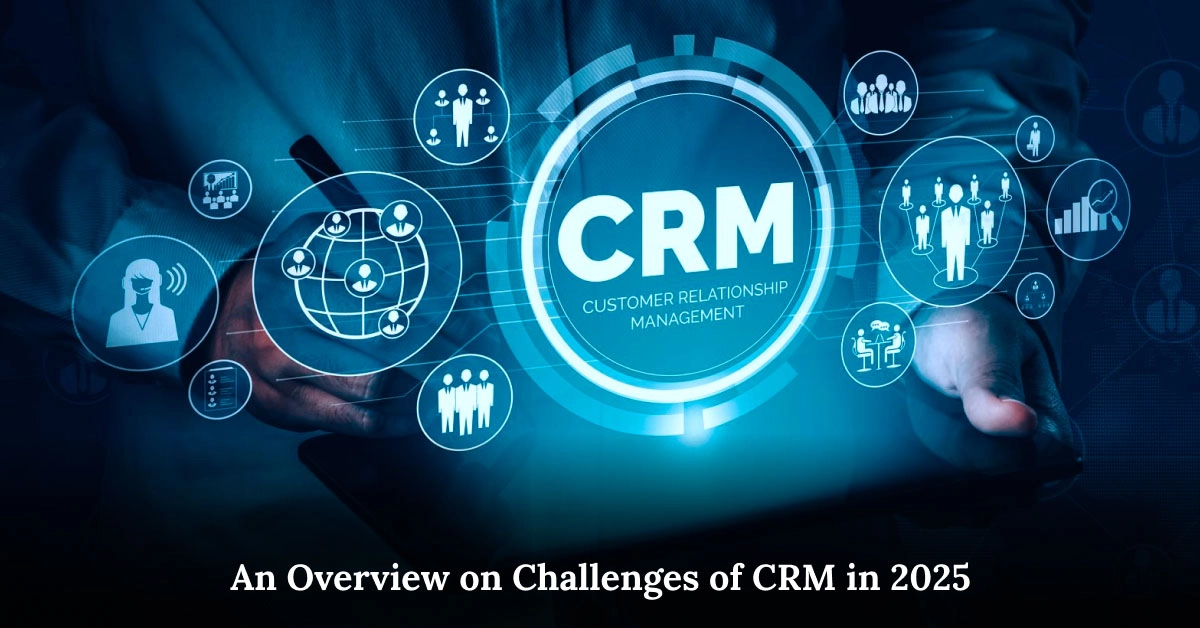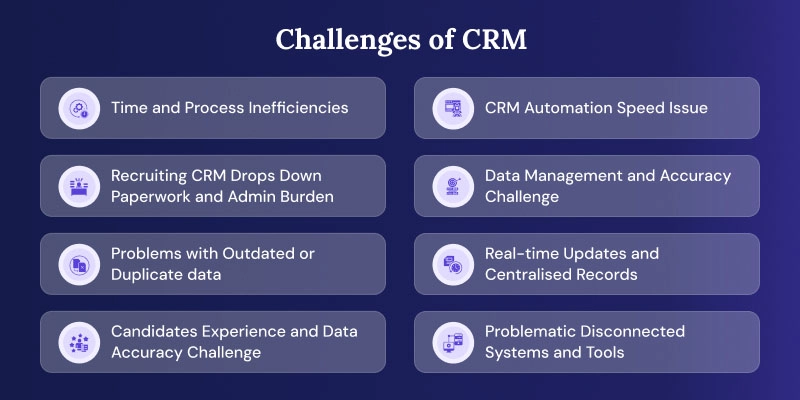An Overview on Challenges of CRM in 2025

You can save lot of manual hours and cost on data entry work by removing all Challenges of CRM Software. Manual tracking needs more countless hours every week without any proper recruiting CRM system. Their takes for the poor candidate experiences and long turnaround times without reason.
Mitigating recruitment challenges through effective CRM implementation gives more benefits than only time savings. As per the industry experts, revising your approach becomes unavoidable growth of business disadvantages when current solutions are going of no use.
A well- recruitment CRM clubs all records with automates repetitive tasks, real-time updates and allows individualised candidate engagement. It lowers paperwork in actual and releases your HR people for more human-centric duties. Successful recruitment CRM selection and deployment begin with strategy, and very important is recruiting CRM information. CRM recruiting software or recruiting CRM software is a major trend today.
Challenges of CRM
Let us have a look on major challenges of CRM and how they can be controlled or avoided by the effective use of recruiting CRM to make HR teams life easy and more efficient to accomplish their hiring goals with planned objectives.

1. Time and Operational Inefficiencies
The conventional recruitment process incurs measurable time and drops down productivity. HR people mostly spend 1 to 2 hours posting a job on various websites and handling their remaining tasks. According to industry research, HR workers in large companies, around 82% commit that they must work hard for the same but required repetitive tasks.
These inefficiencies make tangible effects:
- Prolonged hiring timelines (up to 50% long compared to automated processes)
- Lowered recruiter morale, productivity
- High risk of skipping top candidates who are normally off the market within 10-14 days
The impact extends above just time. Like, manual processes mostly result in errors, inconsistencies, and disconnected detail flow tarnishing your efficiency and candidate experience.
2. CRM Automation Speed Issue
Recruitment CRM software handles this challenge head-on by automating your highest time-consuming tasks. Automation makes key recruitment tasks easy, like resumes screening, setting up interviews, and follow up with candidates; all done automatically. This allows your team focus on building strong relations.
A well-deployed recruitment CRM is a game-changer for HR. Automated processes makes sure for the consistent quality and remove non-required tasks. The hiring process will not affect your recruiters work, there work will be improved by focussing more on more complex and required tasks.
3. Recruiting CRM Drops Down Paperwork and Admin Burden
The administrative load in regular recruitment methods is mainly responsible for dropping down productivity. A recruitment CRM makes sure for the digital safety of documents, and it removes the need for paper. Prospects fill their forms via the web, and so, automatically inputting their data into the shared files.
Automation drops down administrative load via:
- Simplified compliance documentation
- Automatic document collection and new hire checklists
- Centralised database of all candidate interactions
The hiring team may use the time spent on admin tasks to make better relations with candidates or highlight on other necessary hiring decisions. With CRM automation, your recruitment process may become rapid and smart. It would transform the slow, paper-based work into a faster automated system focussing more on relationships.
4. Data Management and Accuracy Challenge
Improper data handling is expensive. Incorrect information costs businesses around £10.24 million a year as per some study report by QX Global Group. Although, it’s still one of the highest recruitment challenges that mostly getting overlooked. This may lead to a bad quality of hiring and recruitment costing a huge amount of money to the respective organisation in the long run. Recruiting CRM handles this very nicely.
Stop Browsing Spreadsheets
Implement Top-Tier Recruitment CRM Solutions Today
5. Problems with Outdated or Duplicate Data
Every year almost 30% of the candidate data gets outdated, making big bottlenecks in your hiring process. Old contact details, Invalid certifications, and incorrect job titles waste lot of time as well as they basically obstruct hiring.
Consider what happens when:
- Recruiters waste hours reaching candidates with invalid information
- Without current job roles or skills data, matching tools gets failed
- Double entries force recruiters to review the same candidate’s many times
This disorganisation remarkably deflects your ability to search qualified talent faster.
Additionally, duplicate profiles lower database search speed and create mess for your recruitment team. CRM automation addresses this challenge.
6. Real-time Updates and Centralised Records
A recruitment CRM solves these challenges by collecting centrally all candidate information in an accessible location. Instead of juggling between different websites, tools, or spreadsheets, your CRM becomes a source of truth for all data of candidates.
Real-time recruitment parameters show prompt insights for open positions, candidate status, and hiring development. This central approach allows you to monitor interactions, control communications, and stay on upside of requirements via one common platform.
7. Candidates Experience and Data Accuracy Challenge
Accurate data really improves the candidate experience. Basically, it avoids the frustration of getting with unsuitable, odd opportunities to candidates who have already shifted their industries / locations.
This improved data management leads to fast, very correct matching between candidates and roles resulting in high engagement rates and more positive experiences via the recruitment process.
8. Problematic Disconnected Systems and Tools
Running between multiple disconnected recruiting platforms makes a technological issue slowing down the hiring process. This fragmentation is a significant bottleneck to efficiency in today’s recruitment landscape.
Below are the major issues with non-integrated platforms:
Working with non-integrated systems makes you to regularly switch between applications, copying and pasting information between platforms. This disconnected approach makes data silos, not required complexity, and remarkable inefficiencies.
The consequences are clear:
- Too many separate tools leading duplicated work and constant tab-switching
- Non-integrated financial processes raise errors and take your organisation to audit risks
- Isolated systems make tracking candidate interactions nearly impossible
As per experts’ opinion, separation of recruitment software from email systems is not the solution. Even though many recruiters still work in the same way.
Ready to Hire Smarter with Niyuk?
Get a Powerful CRM for Recruiters Made for Efficiency
CRM Integrations with ATS, HR, and Email Tools
Latest recruitment CRMs resolves these bottlenecks via comprehensive integrations.
Mostly, they connect with:
- Applicant Tracking Systems – Creating a smooth shift when candidates move from sourcing to application
- LinkedIn Recruiter – Allowing profile exports and viewing member profiles directly within your CRM
- Emailing platforms – Syncing Zoho, Google, Office365 and remaining mailboxes directly within your CRM
You may join with hiring managers more smartly when your CRM connects with in office communication tools like Slack and Teams.
Simplifying Workflows via System Sync
Synchronised systems basically benefit your recruitment workflow via centralisation. Also, email integration automatically documents all correspondence with candidates and clients, removing the need for manual copying and pasting.
This synchronisation makes sure that all team members can access full communication, preventing duplicate outreach.
Above all, integrating your recruitment systems means you’ll no longer need to update various platforms manually – when information updates in one system, it updates everywhere. This approach ultimately makes an easy candidate journey while releasing your team to focus on building rational relationships over managing technology.
Find and Engage the Right Candidates Effectively
In this section, you will find the elaboration of limitations of manual sourcing candidates’ method.
The manual candidate screening process brings many crucial issues. It is very time-consuming, restricting recruiters’ ability to work on relationship-building activities. Also, unconscious bias many times impacts candidate selection, mostly eliminating qualified talent without offering a chance. Maybe most concern is about reactive recruiting leading to fast decisions and potential wrong hires. It potentially costs employers up to 33% of an employee’s first-year salary.
CRM Features for Auto-matching and Job Board Integration
Modern recruiting CRMs give powerful solutions via:
- AI-driven matching algorithms automatically reviewing qualifications and sort candidates into categories like “Best Fit” or “Good Fit”.
- Job board integration allowing posting to many sites simultaneously, improving your candidate pool.
- Automated resume screening finds the most suitable candidates based on skills and experience.
Such features remarkably reduce sourcing time and improving match quality.
In actual, some organisations consume up to 5 hours weekly / recruiter on sourcing and outreach.
Also, Personalised communication and engagement tracking is essential. Recruiting CRMs allow personalised communication via automated yet customised emails, texts, and follow-ups. Also, engagement tracking helps prioritise actively interested candidates, allowing personalised messaging to improvise conversion.
How does Recruiting CRM help reduce time-to-hire?
CRM capabilities impact hiring speed. By implementing such tools, organisations like LHC International get great results, with a 30% reduction in time-to-hire and a 35% increase in overall hiring quality. By creating talent pools and groups of pre-screened candidates, you can match qualified people quickly to new posts without restarting from scratch.
Conclusion
Knowing the challenges which can be resolved with the use of recruitment CRM software shows that conventional methods are no more effective in the hiring market. In this blog, you have studied how CRM solutions resolve problems like time management, data errors, disorganised systems, and talent acquisition issues efficiently.
With recruiting CRM, all candidate data stays right and updated, so your team can focus on the candidates other than wasting time on outdated candidate resumes or redundant tasks. System Integration also removes various technical difficulties which recruiters face daily. It allows the team to focus on to build relationships with candidates. This simplified approach remarkably declines time-to-hire, with some organisations reporting up to 50% improvement after using recruiting CRM tools like Niyuk that offer a free demo before any commitment.
Indeed, selecting the proper recruitment CRM needs consideration of your certain needs. Anyhow, as hiring grows more tedious, those who start these solutions gain a real competitive advantage over those relying on manual processes. For more details you can send us an email on: info@niyuk.ai
Frequently Asked Questions
1. What problems do recruitment agencies usually face, and how can CRM tools help?
Agencies struggle with disjointed candidate data, communication gaps, and managing high volume – the core challenges of CRM. A CRM for recruiters resolves this by centralizing all interactions and pipeline details, bringing clarity and organization to chaos.
2. How can a recruitment CRM make the hiring process faster?
A recruiting CRM software boosts speed through CRM automation. It handles repetitive tasks like scheduling and initial screening, letting recruiters focus on interviewing and placements, drastically cutting down the time-to-hire.
3. How do CRMs help in reducing hiring costs?
Recruitment CRM solutions cut costs by reducing administrative labor via CRM automation tools. They also improve placement quality, reducing expensive turnover, and help build strong internal talent pools, lessening reliance on costly external advertising.
